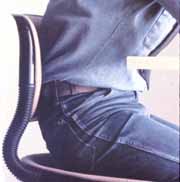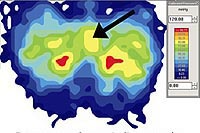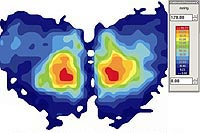It is estimated that over a half of the adult population suffers from periodic or chronic disorders of the genital organs. Approximately 40% of working age men have some kind of erectile dysfunction. Many women suffer from frequent genito-urinary infections. Recent studies indicate that sitting can worsen these problems by increasing temperatures and humidity in the pelvic region and restricting blood flow to the pelvic area.

Circulation to the genital region
When a person sits there are pressures on both bones and flesh. The bone points are your ischial tuberosities (a.k.a, "sit bones") protrusions off the base of your pelvis. The fleshy parts include your buttocks and thighs and the soft tissue between your legs. Now, you can put as much pressure as you like on the ischials - they're built for it. But the soft tissue is another matter.
The soft tissue between your legs is where all the blood vessels, lymph and nerves that supply your genitalia - male or female - are routed. Pressure here can constrict blood vessels or deaden nerves. When you sit, these sensitive tissues can be pressed between the pelvic bones and the chair, and pressure can radiate to the pelvic floor through the pelvic outlet. The longer the pressure is maintained, the greater the risk of damage.
You can test the sensitivity of your circulation by pressing a vein on the back of your hand with a finger. Only a minimal amount of pressure is needed to block blood flow in the vein. It is not difficult to imagine the huge number of blood vessels and nerves that can be blocked when the weight of the upper body squashes them as you sit on a chair.
There is a wide anatomical variation in the genital soft tissues within the population. Some body types - male and female - are likely to be more susceptible to these sitting pressures than others.
Pelvic circulation can be further compromised when sitting with detrimental 90° hip and knee angles and because of inactivity of the feet. It should be no surprise that health problems in the pelvic organs have increased simultaneously with the amount of sedentary work in Western countries.
Male sexual problems and sitting
Designing a healthy seat for men is more difficult than designing a seat for women. Men’s sitting is impaired by the fact that the male pubic bone is almost twice the length of its female counterpart.
Men have a tendency to sit with their pelvis tilted backwards. This unconscious habit relieves pressure on the root of the penis. With the hip tilted backwards and the back rounded, sitting is advantageous to the genital organs but harmful to the disks in the low back region. The more a man leans forward, the worse the effects on his plumbing.

Men tend to sit with their pelvis tilted backwards to relieve pressures to the genitals.
Pressure on the pudendal nerve (the main nerve of the male genital organs) and the surrounding veins can cause impotence in racing cyclists. Some experts believe the same phenomenon occurs when a man sits upright in a conventional ergonomic chair with a 90° hip angle. There have been recent reports of increased erectile dysfunction in Danish male dentists who have been sitting in certain saddle seat designs for many years.

Pressure to the male genitals on a on a one-piece saddle seat.

No pressure to the male genitals on a divided two-part saddle seat.
Fashionable tight pants can also squeeze the genital organs, which are highly sensitive to changes in temperature and compression. A sitting survey conducted by R. Koskelo and O. Hänninen from the physiology department of the University of Kuopio in Finland showed that using ordinary clothing when sitting in conventional chairs raises testicular temperature to approx. 37°C (98.6°F). When using a two-part divided seat (e.g., Salli Twin or href="Salli-MultiAdjuster-Saddle-Stool-P558C156.aspx">Salli Multi), temperatures lowered back to the optimum value of 33°C (91.4 F). A 4°C increase is harmful to the production of sperm cells. The sperm count in Europe has decreased almost by a half during the past 30 years.
Female gynecological problems and sitting
Tight pants combined with the use of sanitary pads and pantiliners can increase the risk of gynecological infection in women who sit for longer periods of time. This is due to inadequate ventilation of the area which leads to increased temperature and humidity. Gynecologists first noticed the phenomenon in the mid-1990’s when the use of pantiliners increased rapidly. Conventional female sitting postures are thought to block ventilation and increase temperatures and humidity in the genital region.
Towards a healthier sitting culture
In our sedentary culture the connection between genital health and sitting is not yet fully understood. Studies are underway to determine whether improved ventilation and reduced pressures to the sensitive genital tissues effected by new chair designs will decrease the risk of infection and pressure-related sexual dysfunctions.
Some contemporary seat designs use mesh upholstery to improve ventilation to the pelvic region. In 1994, Herman Miller introduced the Aeron Chair with a mesh "Pellicle" fabric seat designed to improve ventilation and equalize sitting pressures.
A new seat design by Salli Systems incorporates a center opening to relieve pressures and improve ventilation to the genital area.
Improved sexual health and function are important in intimate areas of life, which you can affect by making the right choices. Many other factors contribute to sexual disorders and genital infections, including high cholesterol levels and diabetes, both of which decrease the circulation to the pelvic area, in addition to alcohol and stress. Health conscious people can also choose breathable, well-designed seating and loose and breathable clothes to improve circulation and ventilation in pelvic region.
Article reproduced with permission from ergoTALK with contributions from Vessi Jalkanen of Salli Systems.